5 Ways to Stop Your Dog from Digging in Your Yard Effectively and Permanently
Many dog owners face the challenge of their pets digging holes in the yard. This behavior can cause damage to lawns, gardens, and fences, creating frustration for those who want to keep their outdoor space neat. Understanding why dogs dig and how to manage this behavior helps maintain a peaceful yard.
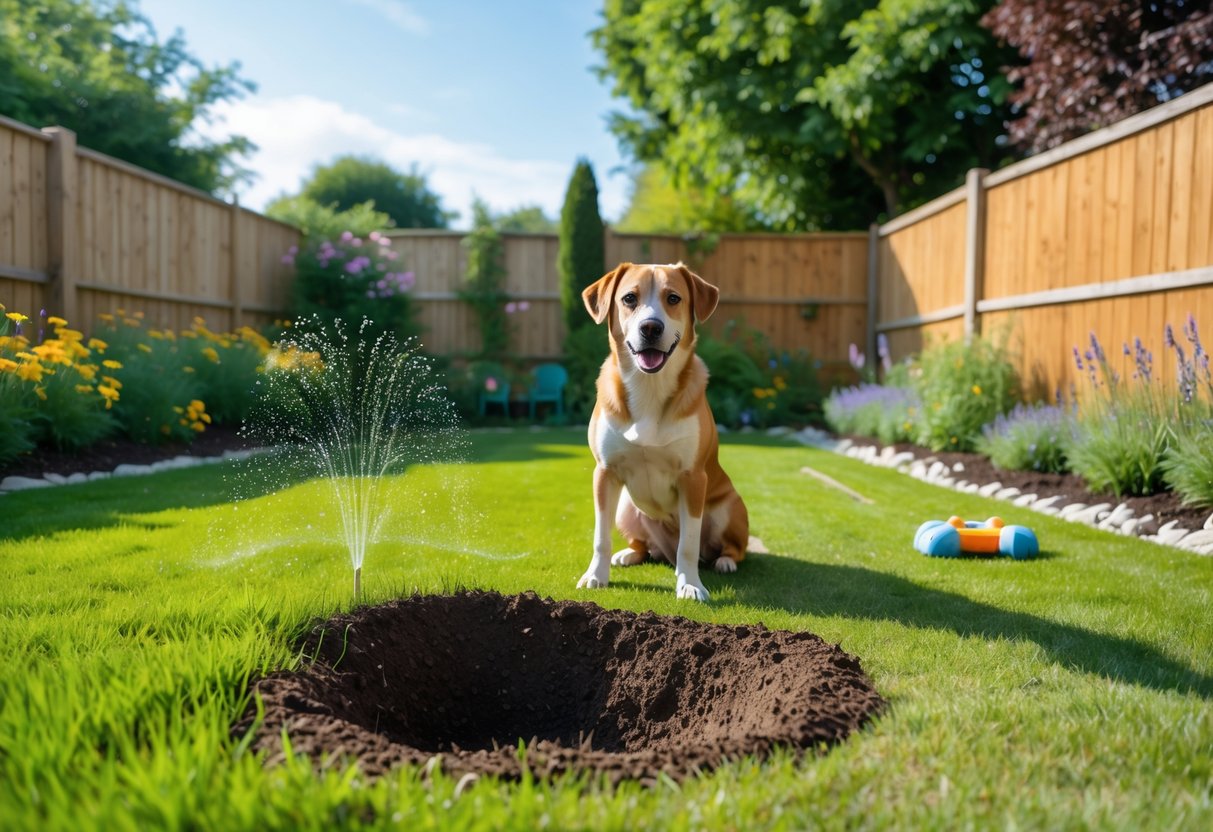
The key to stopping a dog from digging is to address the root causes and provide practical solutions that keep the dog engaged and comfortable. By learning effective strategies, owners can protect their yard while supporting their dog’s natural needs.
1) Increase your dog’s daily exercise to reduce excess energy that leads to digging.
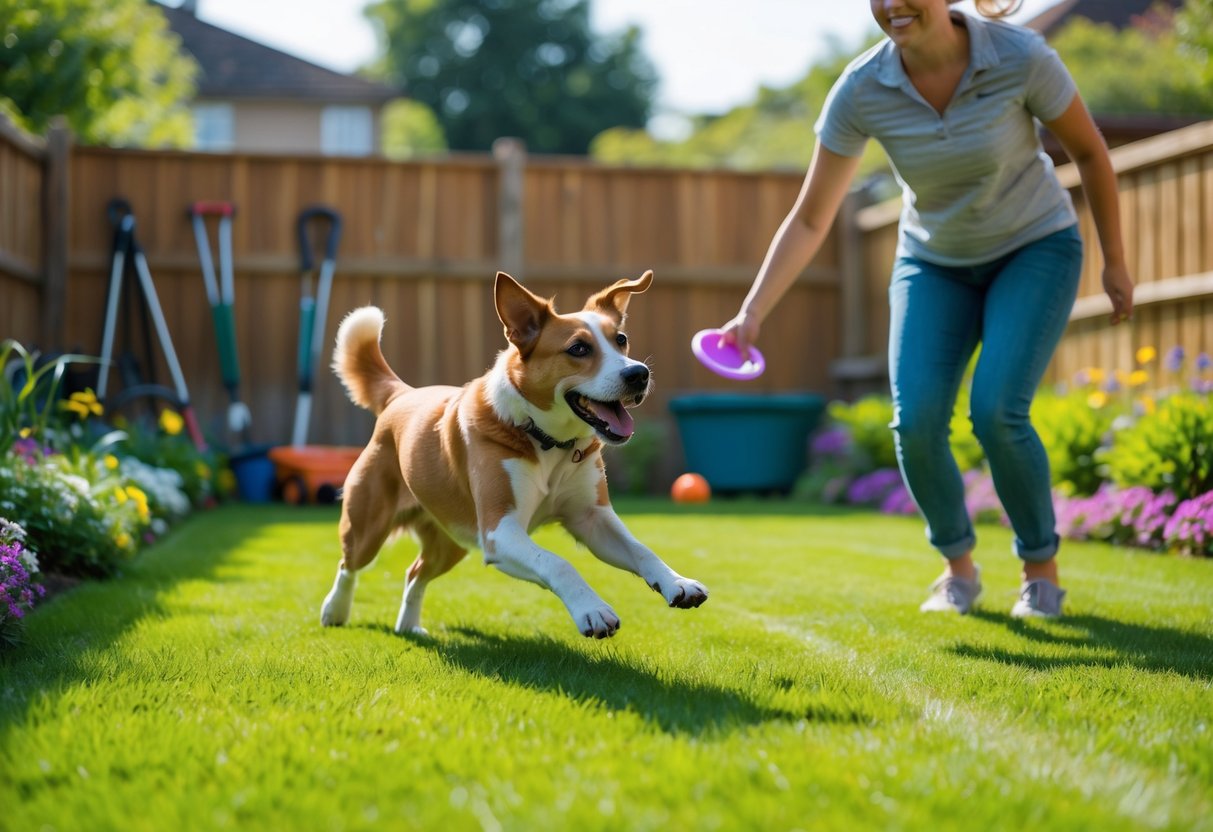
Dogs often dig because they have extra energy that needs to be used. When they do not get enough physical activity, this energy can turn into digging in the yard. Increasing their daily exercise helps burn off that energy in a positive way.
Exercise can include walks, runs, playing fetch, or other activities that get a dog moving. Regular exercise not only tires dogs physically, but also helps keep their minds busy. A tired dog is less likely to dig out of boredom or restlessness.
Providing more exercise can reduce unwanted behaviors like digging, chewing, or barking. It is important to find the right amount and type of activity for the dog’s breed, age, and health. Consistent daily exercise helps keep dogs balanced and focused.
2) Create a designated digging area with loose soil to redirect digging behavior
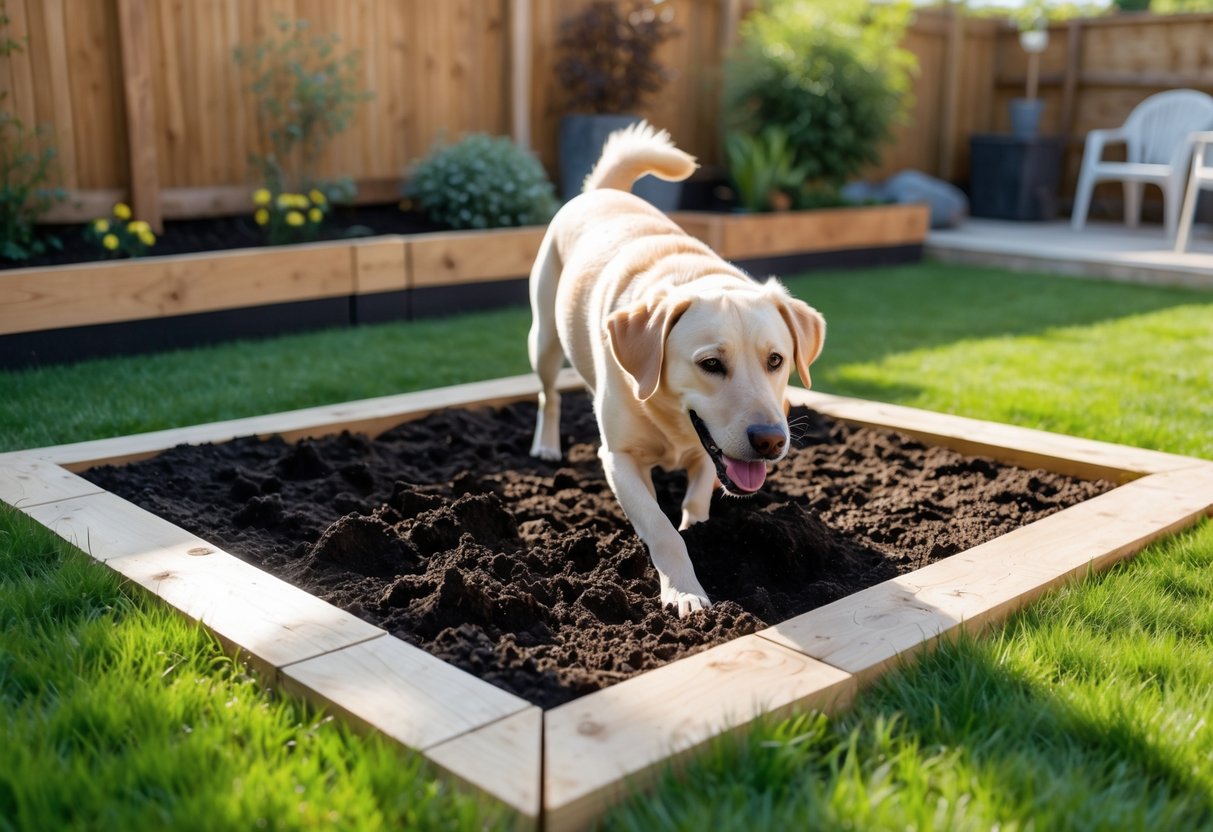
One effective way to manage a dog’s digging is to create a special digging spot in the yard. This area should have loose soil or sand, which makes it easier and more enjoyable for the dog to dig.
The owner can hide toys or treats in this spot to encourage the dog to use it. This helps satisfy the dog’s natural need to dig without damaging other parts of the yard.
When the dog digs outside the designated area, gently guiding them back to the correct spot is important. Making the digging area more appealing than other parts of the yard helps reinforce positive habits.
Spending time with the dog at the digging site can also support this training. Playing or digging together shows the dog that this area is the right place for digging activity.
3) Use deterrents like citrus peels or commercial dog repellents in problem spots.
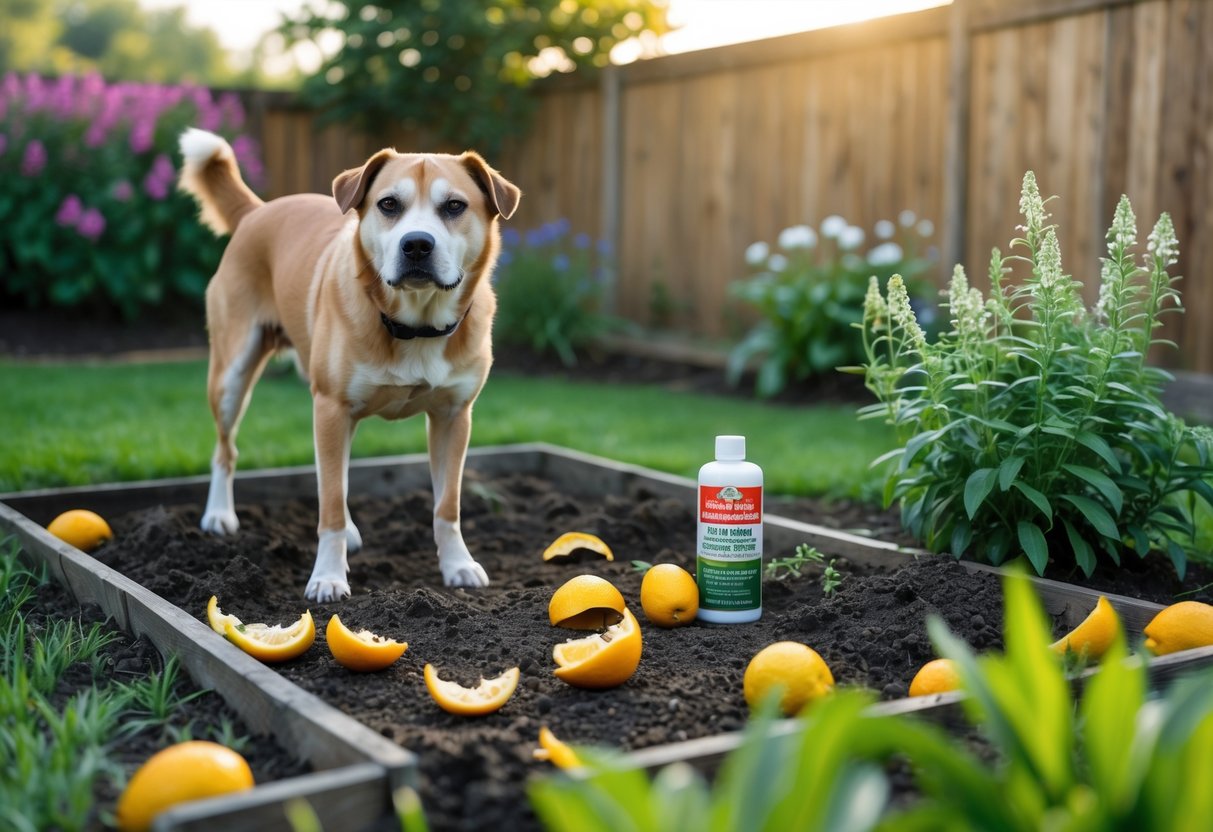
Using deterrents can help keep dogs from digging in certain areas of the yard. Citrus peels, such as orange, lemon, or lime, work well because dogs dislike their strong smell. Placing these peels where dogs tend to dig can make those spots less inviting.
Commercial dog repellents are another option. These products often contain scents or ingredients that dogs find unpleasant. They can be sprayed or sprinkled on trouble areas to discourage digging.
Both citrus peels and commercial repellents are safe when used properly. They do not harm the dog but create a barrier that deters them. Regularly refreshing these deterrents is important since the effects wear off over time.
Choosing the right deterrent depends on the yard and the dog’s behavior. Combining these with other methods can be more effective in managing digging problems.
4) Provide mental stimulation with puzzle toys and training to prevent boredom digging.
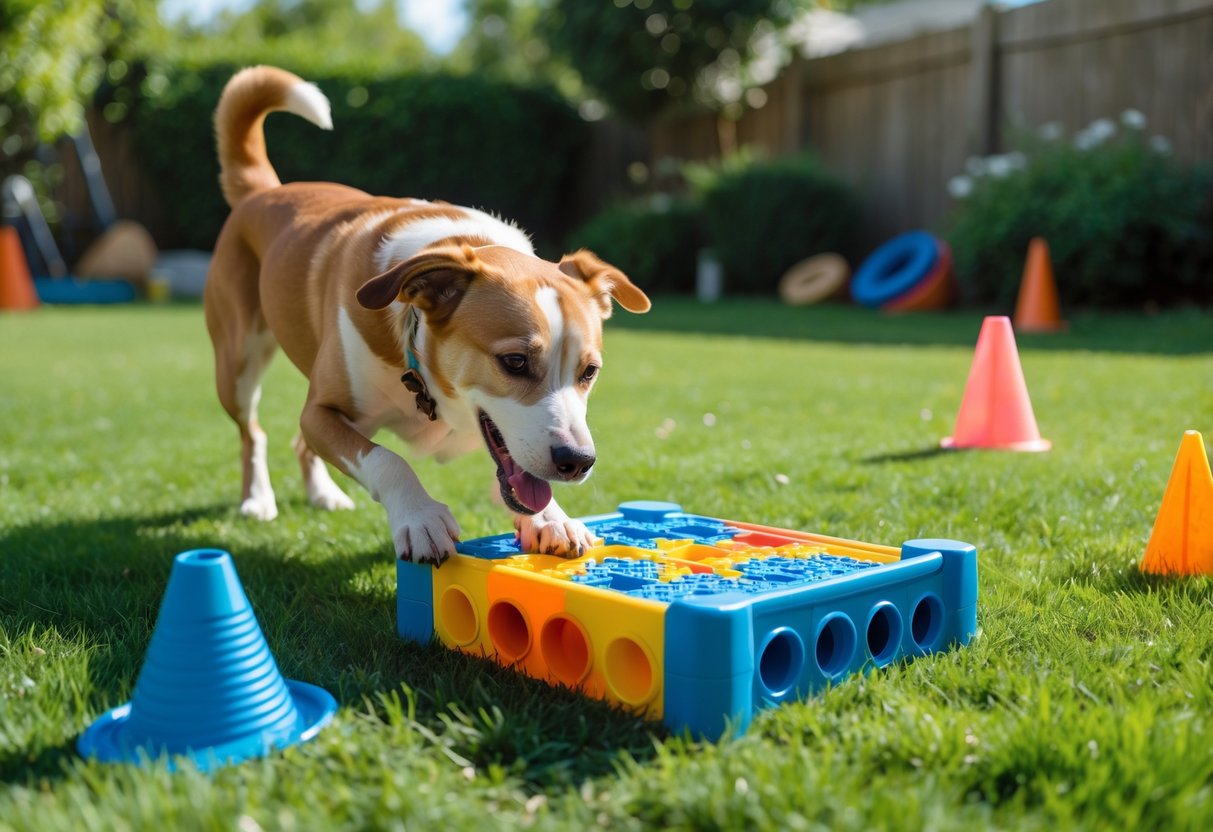
Dogs often dig because they are bored or have extra energy. Puzzle toys help by giving their brains a challenge. These toys make dogs think and work to get a treat or solve a problem. This keeps their mind busy and can reduce the urge to dig.
Training sessions also help with mental stimulation. Teaching new commands or tricks requires focus and attention. This kind of learning tires a dog’s mind, similar to physical exercise.
Including puzzle toys and training in a dog’s daily routine offers variety. It prevents boredom, which is a common cause of digging. When dogs have mental tasks to do, they are less likely to dig just to entertain themselves.
Interactive games like hide-and-seek or scent work can also be useful. These activities keep dogs engaged and provide a positive outlet for energy. Keeping their mind active is key to minimizing destructive behaviors like digging.
5) Install physical barriers such as chicken wire or buried fencing to block access.
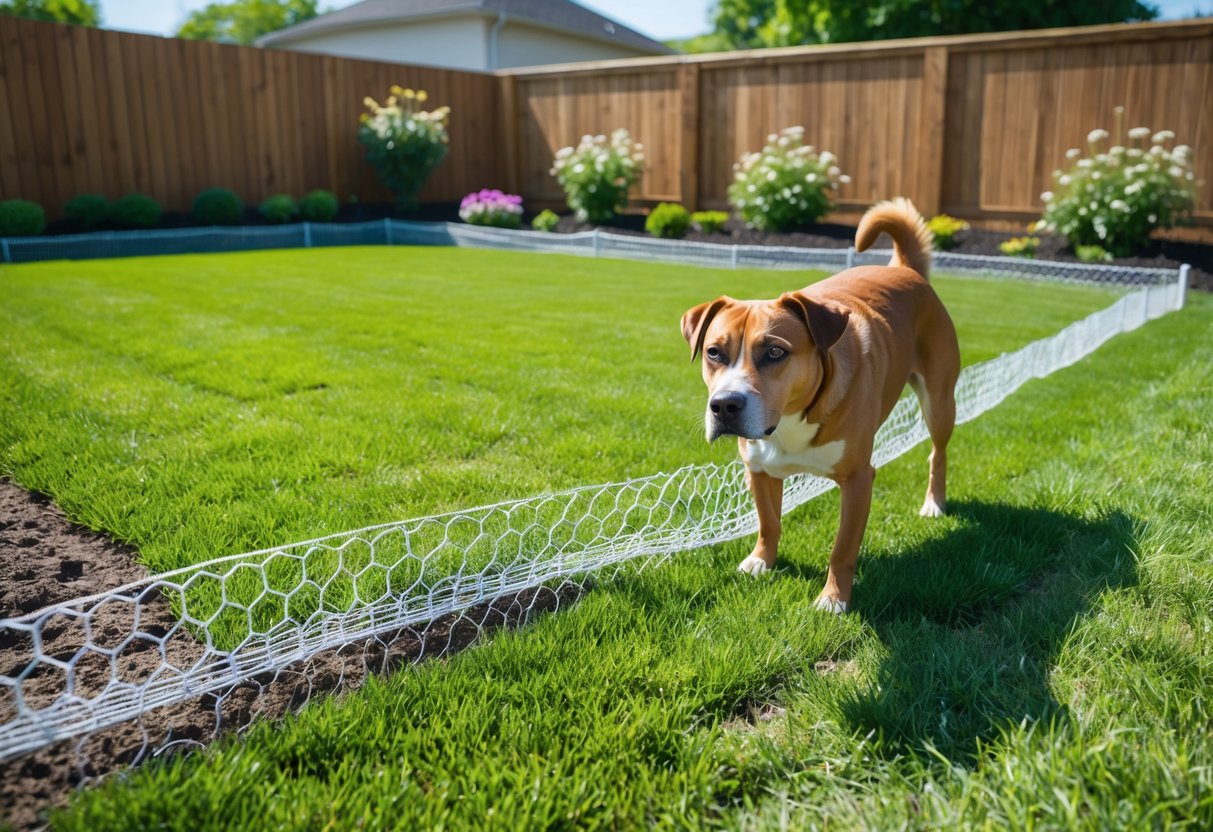
Physical barriers are an effective way to stop dogs from digging under fences. Chicken wire or mesh can be laid on the ground along the fence line to make digging difficult.
Burying the wire a few inches deep adds extra protection. Some use an L-shaped footer, where the wire extends outward underground to block digging further.
Concrete or rocks can also fill trenches to prevent dogs from finding a way out. These barriers should be durable and weather-resistant to last over time.
Using these methods creates a strong, physical stop that dogs cannot easily move or break through. This helps keep dogs safe and yards intact.
Why Dogs Dig: Understanding the Behavior
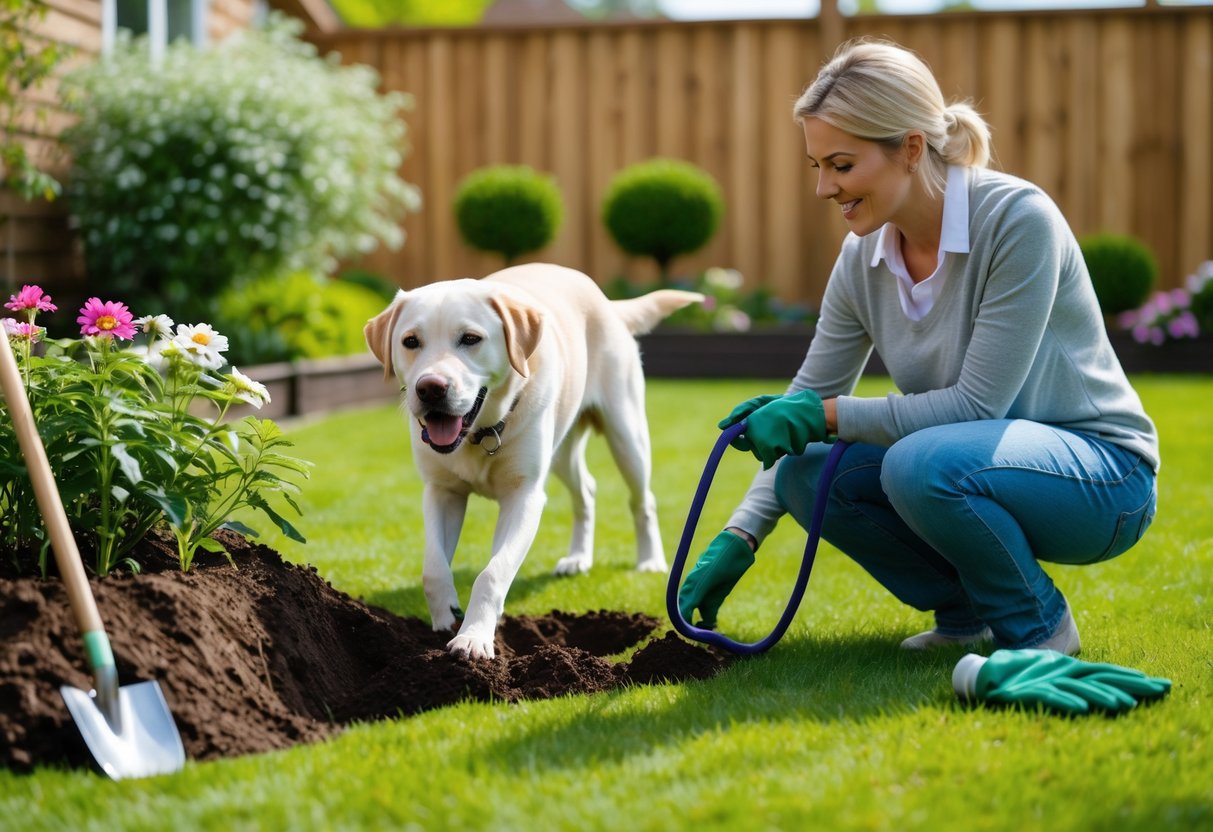
Dogs dig for many reasons, often tied to their needs and environment. This behavior can be triggered by boredom, anxiety, or the desire to find comfort. Some breeds naturally dig more than others due to their instincts and history.
Common Triggers for Digging
Dogs often dig because they want to cool down. On hot days, they may try to make a cool spot in the dirt. Others dig when they feel bored or have too much energy. Lack of exercise or mental stimulation can lead to digging as a way to relieve anxiety or stress.
Some dogs dig to hide toys or food. They may also dig to escape if they feel trapped or seek attention from their owners. Noises or wildlife, like squirrels, can trigger digging as the dog tries to investigate or chase.
Natural Instincts and Breeds Prone to Digging
Digging comes from dogs’ instincts to hunt, bury items, or create a den. In the wild, dogs dig to find prey or build a safe resting spot. Certain breeds are more likely to dig due to their background.
Terriers, hounds, and some working breeds have stronger digging urges. These dogs were bred to track animals or dig out prey, so digging is part of their nature. Understanding a dog’s breed helps predict how much digging is normal for that dog.
Addressing Underlying Issues
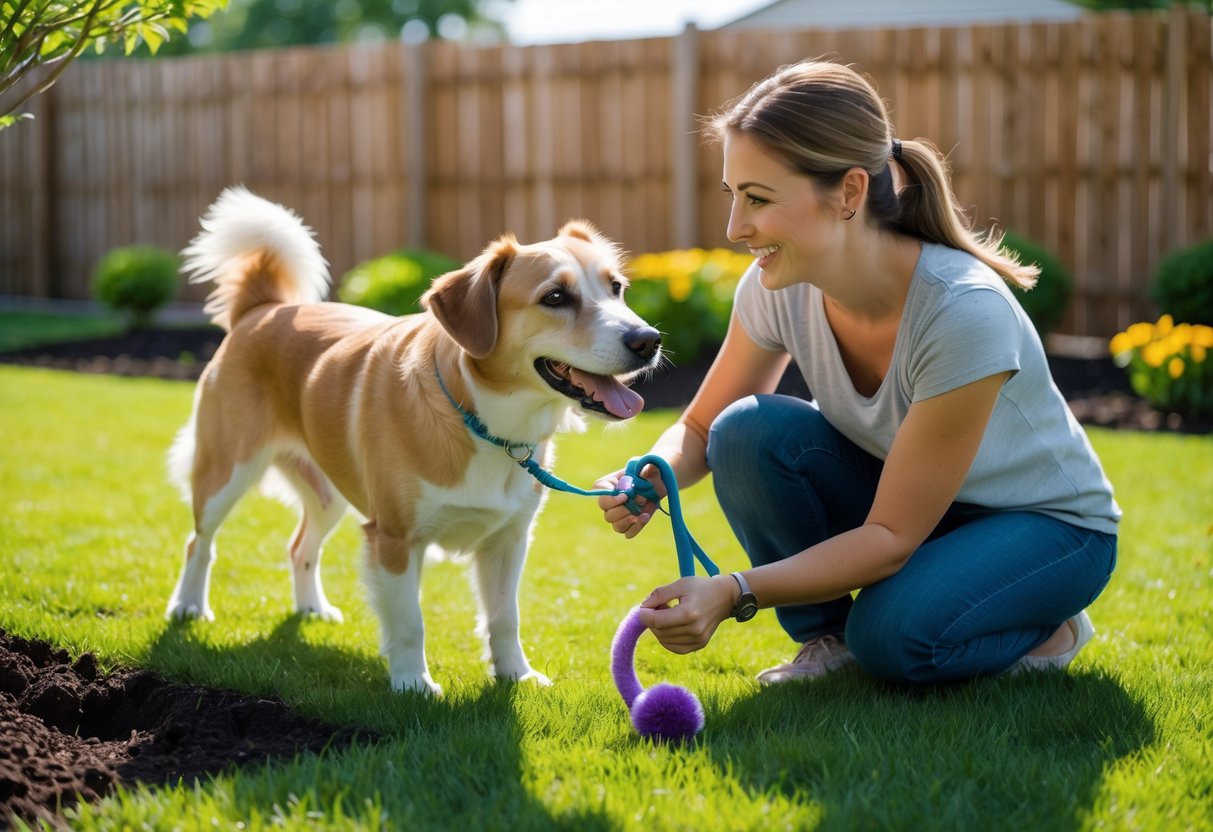
Dogs often dig because they have unmet needs or lack suitable activities. Meeting their physical and mental needs can reduce the urge to dig. Providing mental stimulation and proper exercise are key steps to address the root causes.
Environmental Enrichment for Your Dog
Giving a dog new challenges and toys can keep its mind busy. Puzzle feeders, chew toys, and scent games stimulate natural instincts and reduce boredom. Changing toys regularly helps keep interest high.
Creating a designated digging spot with loose soil lets dogs dig safely without damaging the yard. This gives them an acceptable outlet for digging urges.
Enrichment also involves social interaction. Dogs who feel lonely or bored may dig to get attention. Spending time playing or training can lower digging caused by stress or loneliness.
Ensuring Adequate Exercise and Engagement
Physical activity helps burn energy that might otherwise go into digging. Daily walks, runs, or play sessions match a dog’s need for movement.
The amount of exercise depends on the breed and age. High-energy dogs may need longer or more intense activity to stay calm.
Interactive games like fetch or agility training help focus a dog’s energy. These activities also strengthen the bond between owner and dog, making the dog less likely to dig out of frustration or anxiety.
Long-Term Yard Protection Strategies
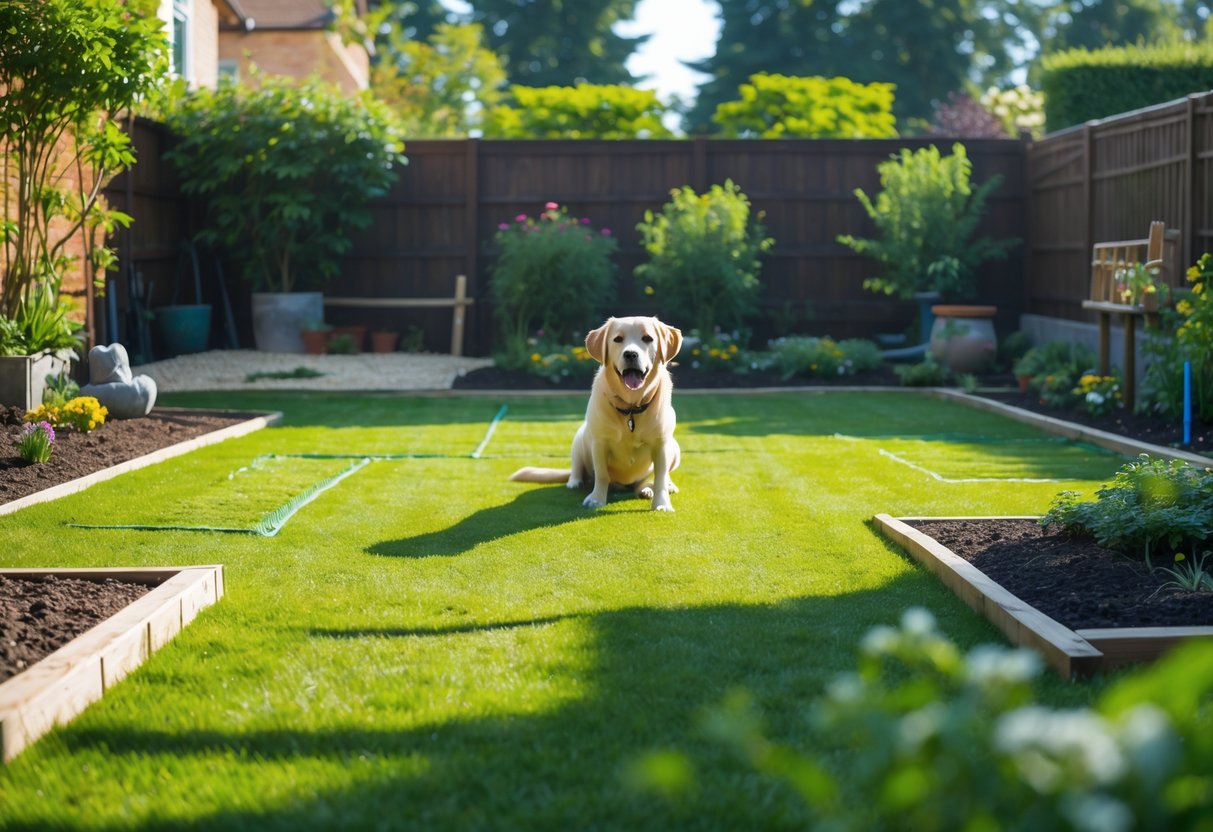
Protecting a yard from digging requires both physical measures and consistent habits. Using safe barriers can block dogs from problem areas. Keeping routines steady helps reduce digging caused by boredom or anxiety.
Safe Barriers and Deterrents
Dogs respond well to clear physical limits. Installing fencing around vulnerable garden beds or sections of the yard keeps dogs out. Raised garden beds or hedges can create natural barriers that discourage digging without harming the dog.
Other options include covering soil with rocks or chicken wire just under the surface. These make digging uncomfortable but not dangerous. Avoid harmful chemicals or sprays that could hurt the dog or other pets.
Using deterrents like motion-activated sprinklers or safe noise devices also teaches dogs to stay away. Changing the yard’s layout to create a designated digging area can redirect the behavior. This space should have loose soil and toys to encourage digging there instead.
Maintaining a Consistent Routine
Dogs often dig out of boredom, anxiety, or excess energy. A steady routine of daily exercise reduces these causes. Activities like walks, fetch, or training sessions tire the dog physically and mentally.
Feeding the dog at consistent times helps lower stress that might trigger digging. Offering regular playtime with toys keeps the dog busy and satisfied.
If digging happens consistently at certain times or places, addressing those triggers is important. Keeping the yard tidy and free of tempting objects can reduce urges to dig.
Training with commands such as “leave it” or “no dig” combined with positive rewards reinforces good behavior. Consistency from all family members is key to making these habits stick.
Frequently Asked Questions
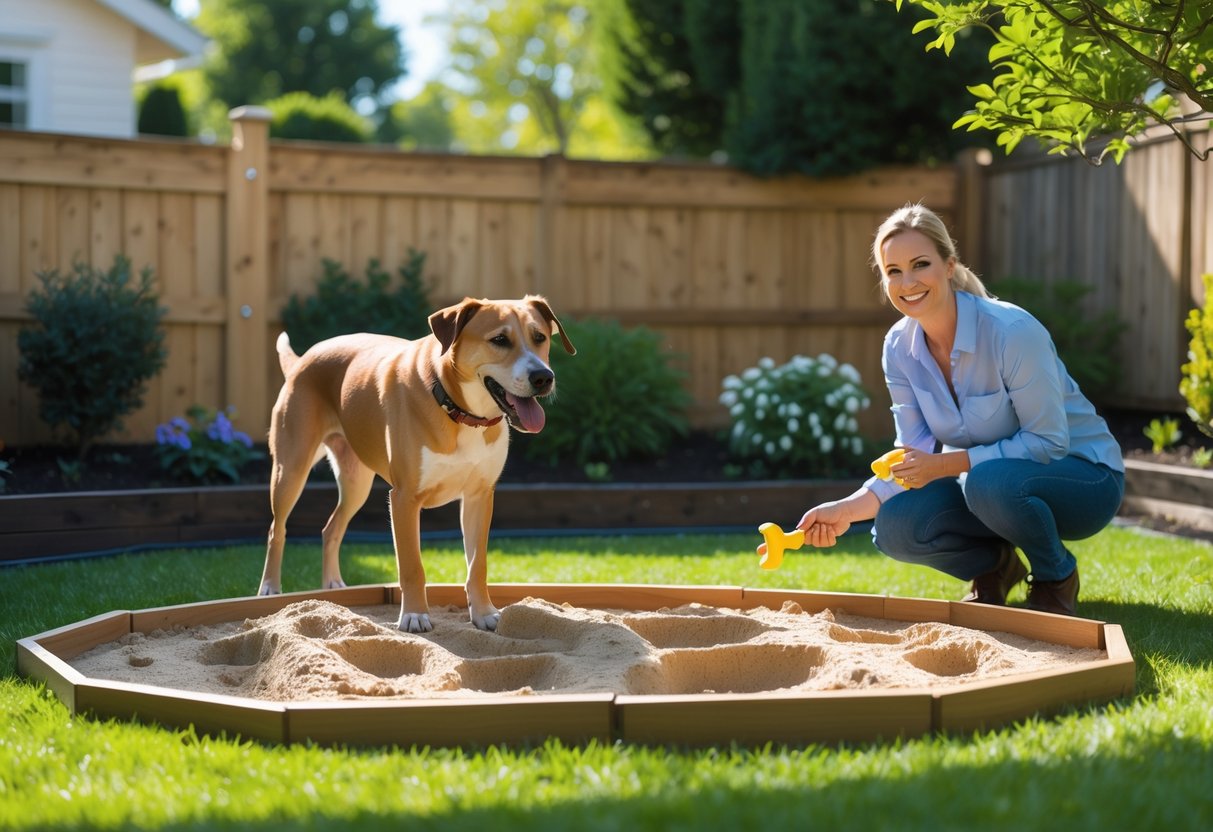
Dogs dig for many reasons, including boredom, excess energy, or natural instincts. Addressing these causes involves a mix of training, yard changes, and sometimes using safe deterrents.
What are effective training techniques to prevent a dog from digging?
Consistent commands like “leave it” or “no dig” help teach limits. Reward the dog when it stops digging or follows a command. Redirecting the dog to a designated digging spot also supports good habits.
How can I modify my yard to deter my dog from digging?
Creating a designated digging area with loose soil gives the dog a proper place to dig. Adding barriers like chicken wire under the topsoil prevents digging in sensitive areas. Raised garden beds can protect plants.
Are there specific deterrents safe for dogs that stop them from digging?
Citrus peels scattered in problem spots work well to deter dogs. Commercial dog repellents designed for yards are safe and effective when used as directed. No harsh chemicals should be applied.
What are common reasons dogs dig and how can I address them?
Dogs dig due to boredom, excess energy, anxiety, or instinct. Increasing daily walks and exercise reduces energy. Mental stimulation with puzzle toys prevents boredom. Addressing anxiety may require behavior training or veterinary advice.
How can I reinforce positive behaviors to keep my dog from digging?
Praise and treats immediately after following commands or using the digging area encourage good behavior. Consistency is key. Ignoring unwanted digging, while rewarding desired actions, strengthens learning.
Can certain breeds be more prone to digging and how can I manage this?
Yes, breeds like terriers and hounds dig more due to strong instincts. Managing this involves providing more exercise and mental challenges. Creating a dedicated digging spot helps redirect their natural behavior.
